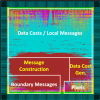1427 search results - page 86 / 286 » Markov Random Field Modeling in Computer Vision |
CVPR
2009
IEEE
15 years 4 months ago
2009
IEEE
Belief propagation (BP) is an effective algorithm for solving energy minimization problems in computer vision. However, it requires enormous memory, bandwidth, and computation beca...
WACV
2007
IEEE
14 years 3 months ago
2007
IEEE
We present a method for the simultaneous detection and segmentation of objects from static images. We employ lowlevel contour features that enable us to learn the coarse object sh...
AINA
2004
IEEE
14 years 27 days ago
2004
IEEE
: Wide area network (WAN) -based distributed computing (DC) has become an active field of research, especially under the label of grid computing. On the other hand, research on WAN...
CVPR
2011
IEEE
13 years 4 months ago
2011
IEEE
This paper presents a complete solution to estimating a scene’s 3D geometry and appearance from multiple 2D images by using a statistical inverse ray tracing method. Instead of ...
ICPR
2008
IEEE
14 years 3 months ago
2008
IEEE
One of the major limitations of HMM-based models is the inability to cope with topology: When applied to a visible observation (VO) sequence, HMM-based techniques have difficulty ...


